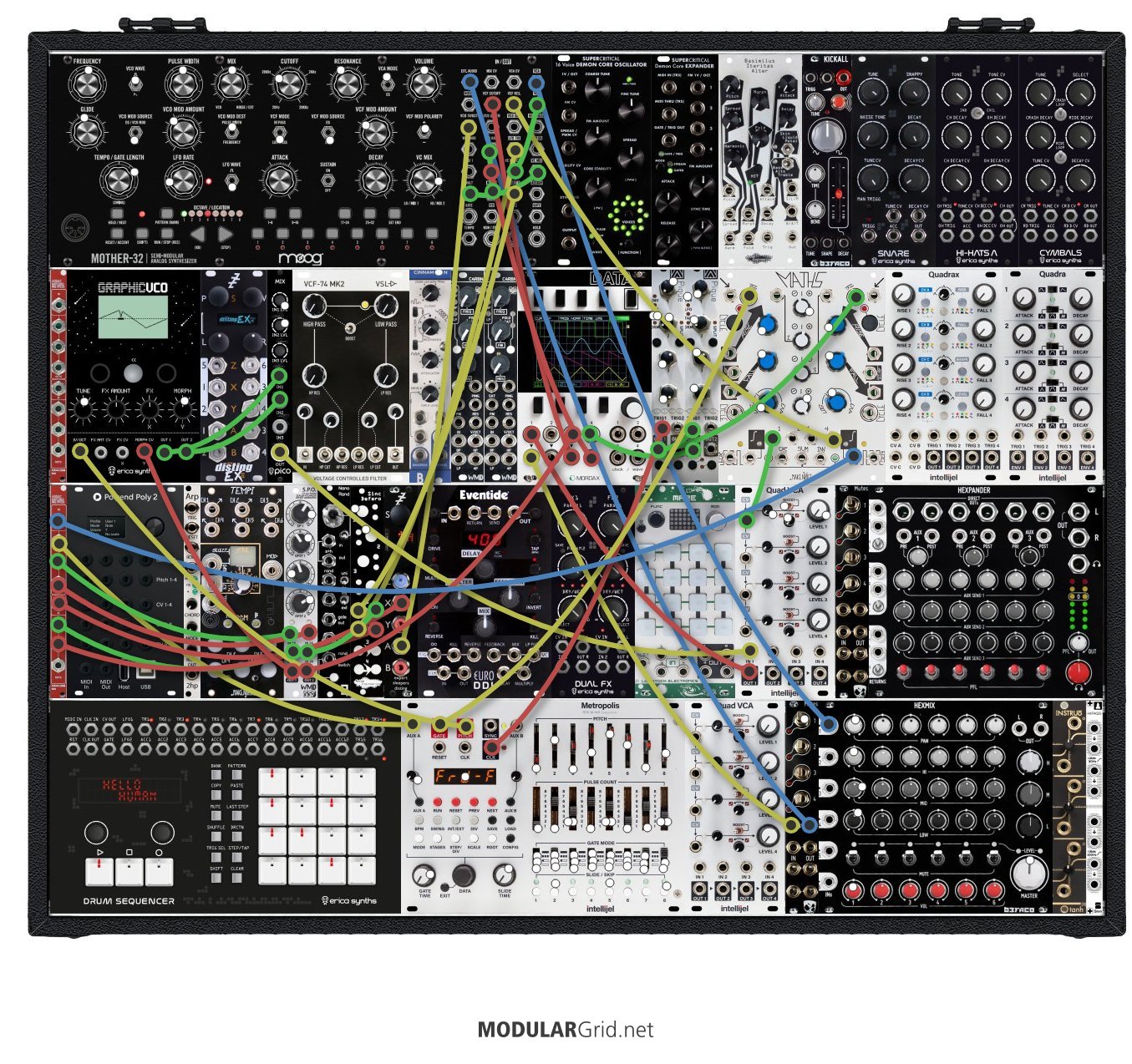OVERVIEW
The goal of this patch initially was to get acquainted with the 2 channels of WMD S.P.O., each with Scale/Polarize (Attenuversion) & Offset controls. For the "A" inputs of channels 1 and 2 on SPO I have multiplied the same envelope from the CH. 4 unity output of Maths. This is a bi-timbral patch, taking the undulating Square wave of M32 with its own quantized pitches, as well as the Morphed dual-wave output of Graphic VCO with a quantized sequence from Metropolis. Each channel of SPO then has another input:
SPO
1A: Maths CH. 4 Unity Out
1B: M32 Triangle LFO via Attenuverter on Sinc Defero
2A: Maths CH. 4 Unity Out
2B: Pique #2 ADSR Envelope (attenuated twice, in M32 and then in Sinc Defero)
Out 1: Graphic VCO Morph Input
Out 2: M32 VCF Cutoff via Data channel 3
METROPOLIS
Providing the clock and most of the initial gate and pitch information, Metropolis works as follows:
Scale: Minor Pent (PEnT-)
Octave: 1 octave range
BPM: 120
8-stage
Forward mode
AUX A: Ratchet
With an odd number of pulses in an 8-stage sequence, phrases start and stop offset from - but subtly related to - the rest of the patch
PIQUE
Pique #1 is using the Trigger Stream Randomizer algorithm, the "Expert" mode beneath "Tap". This stream of triggers, derived from the Clock output of Metropolis, sends triggers that have a probability of either not appearing or multiplying in the gap between 2 Metropolis clock pulses. Playing with Delay time (3rd knob) did not yield very helpful results, but adding some Jitter (4th knob) was interesting, as it did not upset the "big beats". Pique #1 goes to Pique #2 and Maths CH. 4 trig in.
Pique #2 is a simple ADSR envelope, receiving triggers from the same random trigger stream in Pique #1 as is being fed to Maths channel 4 trig in. The goal of this ADSR is to influence the M32 LFO, at depths that are controlled by the VC Mix on M32.
GRAPHIC VCO
Taking the morphed mix of Wave 01 from "Acid" and Wave 07 from "Basic" (Tri-saw) out into Pico Mix for levelling each wave, pitched by Metropolis.
DATA
Monitors
CH. 1 - Summed Output of Graphic VCO via Quad VCA CH. 1
CH. 3 - S.P.O. CH. 2 output
CH. 4 - Pique #2 Out 1
DISTING MK4
A6 Quantizer: Quantizer is fed voltages from the Triangle LFO on M32 (itself influenced by the ADSR of Pique #2 triggered at semi-random intervals via Pique #1). At first this is kept at Scale: 5 (Fifths) but in performance can move to Scale: 4 (Minor triads). Also, start with Parameter 0 (Attenuation) at 6, then move up to 31. The Attenuator on Disting MK4 works like a "fine tune" attenuation of the 2nd attenuator on Sinc Defero, which works like "Coarse Tune" as to how much of the LFO is sent to the quantizer (Sinc Defero's 2nd channel also works to attenuate the influence of the LFO on the Morph CV of Graphic VCO)
MATHS
CH. 1 Triggers Quad VCA CH. 1 CV input taking its gate from Metropolis directly.
CH. 4 Attenuverted Out goes to the Resonance on M32, and negative voltages can create interesting inverse relationships with cutoff and resonance in the M32 filter
CH. 4 Unity Out was explained above as feeding both 'A' inputs on S.P.O.
M32
Quantized out from Disting controls the 1v/oct of M32 and thus half of the pitch information heard in the patch (amount between those pitches/M32 timbre and Metropolis pitches/Graphic VCO timbre selected via MIX knob). The Triangle LFO out influences both the SPO Channel 1 'B' input and is the sole information (other than attenuation values) used for the quantizer setting the pitch of M32. The waveshape of the Triangle LFO is a mix between Triangle and the attenuated ADSR from Pique #2 (attenuation of which is influenced by the M32 Filter output via VC Mix Control input)
Octavian


